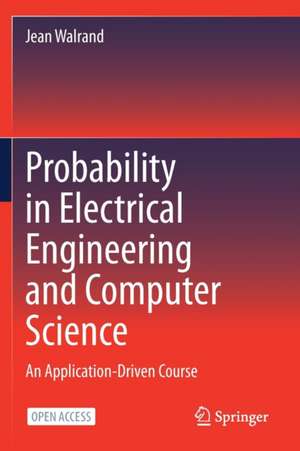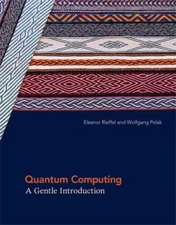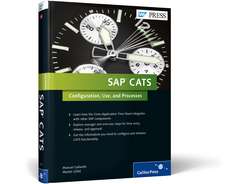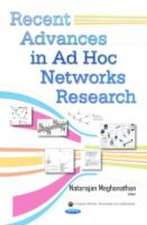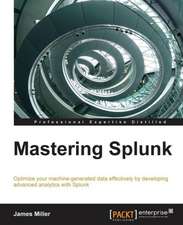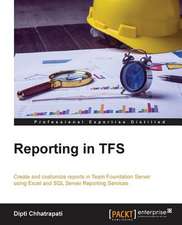Probability in Electrical Engineering and Computer Science: An Application-Driven Course
Autor Jean Walranden Limba Engleză Paperback – 24 iun 2022
This is an open access book.
| Toate formatele și edițiile | Preț | Express |
|---|---|---|
| Paperback (2) | 240.57 lei 3-5 săpt. | +25.35 lei 5-11 zile |
| Springer International Publishing – 24 iun 2022 | 240.57 lei 3-5 săpt. | +25.35 lei 5-11 zile |
| Quoi? – | 402.15 lei 6-8 săpt. | |
| Hardback (1) | 341.95 lei 6-8 săpt. | |
| Springer International Publishing – 23 iun 2021 | 341.95 lei 6-8 săpt. |
Preț: 240.57 lei
Preț vechi: 300.71 lei
-20% Nou
Puncte Express: 361
Preț estimativ în valută:
46.05€ • 50.03$ • 38.71£
46.05€ • 50.03$ • 38.71£
Carte disponibilă
Livrare economică 31 martie-14 aprilie
Livrare express 15-21 martie pentru 35.34 lei
Preluare comenzi: 021 569.72.76
Specificații
ISBN-13: 9783030499976
ISBN-10: 3030499979
Pagini: 380
Ilustrații: XXI, 380 p. 214 illus., 146 illus. in color.
Dimensiuni: 155 x 235 x 34 mm
Greutate: 0.57 kg
Ediția:1st ed. 2021
Editura: Springer International Publishing
Colecția Springer
Locul publicării:Cham, Switzerland
ISBN-10: 3030499979
Pagini: 380
Ilustrații: XXI, 380 p. 214 illus., 146 illus. in color.
Dimensiuni: 155 x 235 x 34 mm
Greutate: 0.57 kg
Ediția:1st ed. 2021
Editura: Springer International Publishing
Colecția Springer
Locul publicării:Cham, Switzerland
Cuprins
Chapter 1. Page Rank - A.- Chapter 2. Page Rank - B.- Chapter 3. Multiplexing - A.- Chapter 4. Multiplexing - B.- Chapter 5. Networks - A.- Chapter 6. Networks - B.- Chapter 7. Digital Link - A.- Chapter 8. Digital Link - B.- Chapter 9. Tracking - A.- Chapter 10. Tracking - B.- Chapter 11. Speech Recognition - A.- Chapter 12. Speech Recognition - B.- Chapter 13. Route planning - A.- Chapter 14. Route Planning - B.- chapter 15. Perspective & Complements.- A. Elementary Probability.- B. Basic Probability.- . Index.
Notă biografică
Jean Camille Walrand is a professor emeritus of Electrical Engineering and Computer Science at UC Berkeley. He received his Ph.D. from the Department of Electrical Engineering and Computer Sciences department at the University of California, Berkeley, and has been on the faculty of that department since 1982. He is the author of "An Introduction to Queueing Networks" (Prentice Hall, 1988), "Communication Networks: A First Course" (2nd ed. McGraw-Hill,1998), and “Uncertainty: A User Guide” (Amazon, 2019) and co-author of "High-Performance Communication Networks" (2nd ed, Morgan Kaufmann, 2000), "Communication Networks: A Concise Introduction" (2nd ed, Morgan & Claypool, 2017), "Scheduling and Congestion Control for Communication and Processing networks" (Morgan & Claypool, 2010), and “Sharing Network Resources” (Morgan & Claypool, 2014). His research interests include stochastic processes, queuing theory, communication networks, game theory, and the economics of theInternet. Walrand has received numerous awards for his work over the years. He is a Fellow of the Belgian American Education Foundation and of the IEEE. Additionally, he is a recipient of the Lanchester Prize, the Stephen O. Rice Prize., the IEEE Kobayashi Award, and the ACM SIGMETRICS Achievement Award.
Textul de pe ultima copertă
This revised textbook motivates and illustrates the techniques of applied probability by applications in electrical engineering and computer science (EECS). The author presents information processing and communication systems that use algorithms based on probabilistic models and techniques, including web searches, digital links, speech recognition, GPS, route planning, recommendation systems, classification, and estimation. He then explains how these applications work and, along the way, provides the readers with the understanding of the key concepts and methods of applied probability. Python labs enable the readers to experiment and consolidate their understanding. The book includes homework, solutions, and Jupyter notebooks. This edition includes new topics such as Boosting, Multi-armed bandits, statistical tests, social networks, queuing networks, and neural networks. The companion website now has many examples of Python demos and also Python labs used in Berkeley.
- Showcases techniques of applied probability with applications in EE and CS;
- Presents all topics with concrete applications so students see the relevance of the theory;
- Illustrates methods with Jupyter notebooks that use widgets to enable the users to modify parameters.
Caracteristici
Showcases techniques of applied probability with applications in EE and CS Presents all topics with concrete applications so students see the relevance of the theory Illustrates methods with Jupyter notebooks that use widgets to enable the users to modify parameters This book is open access, which means that you have free and unlimited access
